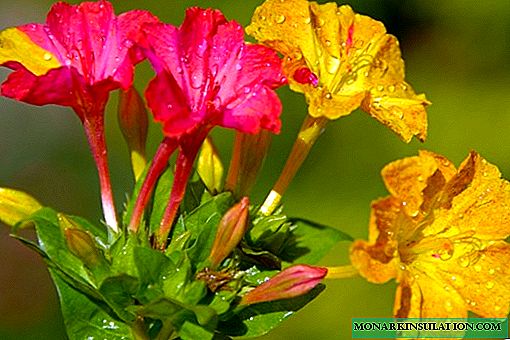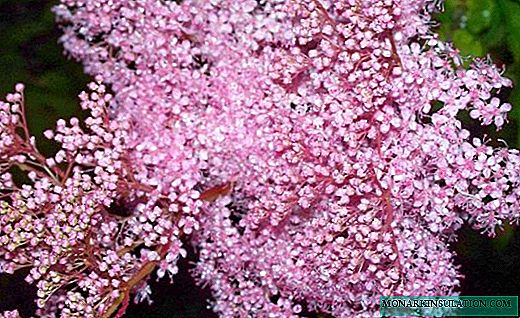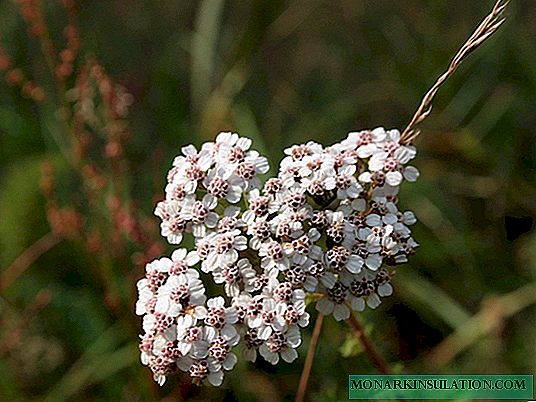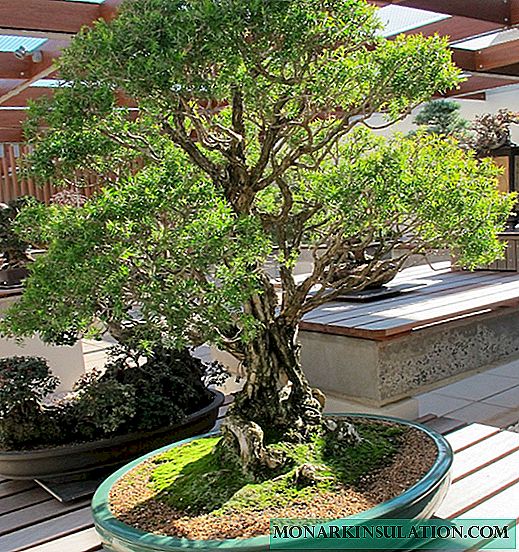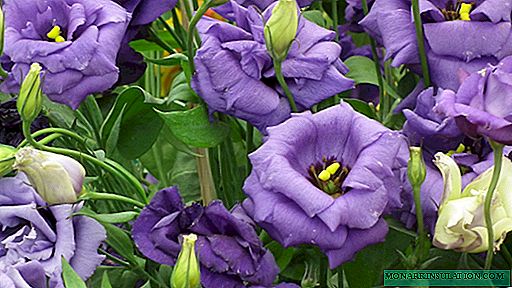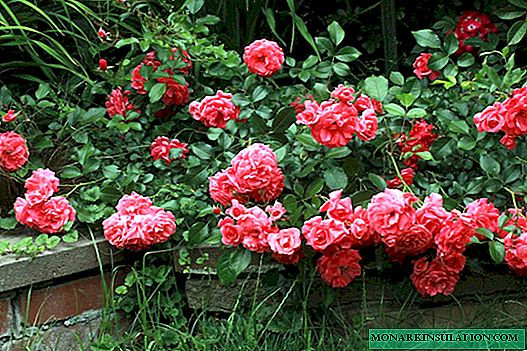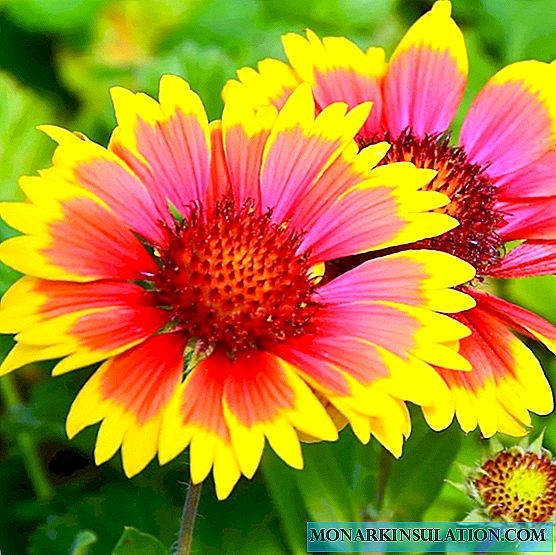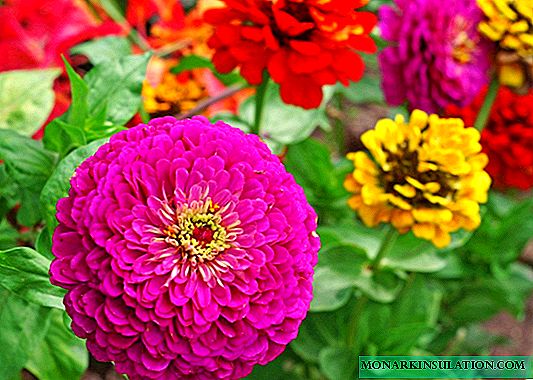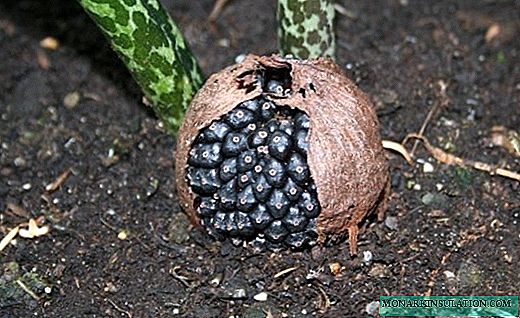Sauromatum is a very exotic plant for our country; it belongs to the Aroid family and is widespread in East Asia (from the Himalayas to India and Nepal). It prefers moist tropical forests at a height of 1.6-2.4 km above sea level. Sauromatum has a very interesting appearance, a single leaf with a round, narrow ears rises above the tuber. It is grown mainly as a houseplant, but can be grown in open ground. For its unusual appearance and methods of growing sauromatum is often called the "Voodoo lily" or "the cob in an empty glass."

Botanical Description
Sauromatum is a tuberous perennial plant. At its base there is a single spherical or oblate tuber with a diameter of up to 20 cm. Its flesh is covered with a rough, light gray skin. From the top of the tuber, 1 to 4 leaves bloom on a long stalk. Their number depends on the age and size of the tuber. The size of the fleshy, stalk-like petiole can reach 1 m in length and 2-3 cm in width. The leaf has a palm-dissected shape. The total height of an adult plant in indoor conditions is 1-1.5 m.
The base of the sheet is covered with an unusual bract. It is painted in a bluish-olive color and is covered with many small burgundy spots. The leaf is preserved until flowering is complete. The leaf plate is heart-shaped and dissected into several lanceolate lobes. The size of the central lobe is 15-35 cm in length and 4-10 cm in width. The side parts differ in more modest dimensions.













The flowering period is in the spring. The flower stalk is closed with its own veil 30-60 cm high. The veil is wrapped around the flower and closes at its base. An inflorescence in the shape of an ear consists of many same-sex flowers. They do not have perianths. The upper part of the inflorescence is a sterile appendage up to 30 cm high and 1 cm thick. The flower is colored with purple and dark pink colors with greenish and brown spots. The blooming sauromatum exudes an intense, not too pleasant smell, in a warmer room it becomes even stronger.
An interesting feature is that when you touch the inflorescence it is very hot. The temperature difference is 10-25 ° C.
After flowering, small fleshy berries are collected on the cob, collected in a spherical head. Each bright red berry contains a single seed. Pollination in the homeland occurs with the help of a small group of insects, so it is very rare to pollinate and bear fruit in a culture.

All parts of the Voodoo Lily are poisonous, so animals and children should not be allowed into plants. Transplanting and trimming work is also recommended in protective gloves, and then wash your hands well.
Types of sauromatum
In nature, 6 species of sauromatum have been registered, but only a couple of them can be found in culture. Most popular is sauromatum drip or guttum. Its dissected, long-leaved leaves are painted dark green and covered with an olive blanket. On the surface of the leaves are burgundy or purple round spots. The cob-shaped inflorescence is colored purple. It blooms in May. The length of the cob is about 35 cm. Around it is a spacious red-green veil. At the base is a large, angular tuber with a diameter of up to 15 cm.

Sauromatum veins. The plant has thick, long petioles with dissected, broadly lanceolate leaves. Leaf plates are attached in a semicircle to the curved part of the petiole; they have a lighter color. The spots are clearly visible only on the petioles and at the base of the leaves. The flower opens in the spring with a slight bang. The tube of the bedspread completely hides its base to a height of 5-10 cm. Flowering lasts about a month and is accompanied by an intense aroma attracting flies.

Reproduction and transplantation
Reproduction of sauromatum occurs in a vegetative way. As they grow, small children form on the tuber. In autumn, when digging up a plant, young nodules are separated from the main plant. During the season they form from 3 to 7 pieces. All winter they are stored in a dry and cool place without soil and only planted in spring. Children immediately begin to grow, release leaves and bloom in the first year. They differ from older specimens only in the number of leaves and the size of the flower.
Planting tubers in the ground begins in March. For planting, small wide tanks with fertile soil are used. The pot must be stable so as not to fall under the weight of a massive flower and leaves. You can buy universal garden soil or make it yourself from the following components:
- turf land:
- compost;
- peat;
- sheet earth;
- river sand.

In early spring, a flower shoot begins to appear on the tuber. Until flowering is completed, sauromatum does not need soil. It consumes tuber stocks, so it can be placed temporarily not in the ground, but in a glass flask. Such exotic will not go unnoticed. By the formation of leaves, the tuber should already be in the ground.
In mid-May, when the danger of night frost disappears, tubers can be planted immediately in open ground to a depth of 10-13 cm. 1-2 months after planting, flowers will appear, and after they wither, the leaves will bloom. In the fall, when the leaves fade, the tubers are dug up and stored.
Cultivation and care
Sauromatums are grown as a houseplant. In the southern regions, you can also grow them in open ground. Smaller nodules tolerate better cooling and are able to winter at low temperatures. Care at home for sauromatum will not be difficult. The optimum air temperature is + 20 ... +25 ° C. Cooling up to +12 ° C is possible.

The plant prefers sunny or slightly shaded places. Indoors, it is grown in the eastern or western windowsills. In the summer heat, you should often ventilate the room or expose the pot to fresh air. With a lack of light, the leaves will become smaller and lose their pattern.
Water the sauromatum regularly, but with a small amount of water. Excessively moist soil will become a hotbed of mold and the tuber will rot. The top layer of the earth should dry up periodically, and excess water should leave the pot. From August, watering is gradually reduced, and after withering of the shoots and until the new growing season, sauromatum is no longer watered.
During the period of active growth, you can make a small amount of fertilizer. Sauromatum is undemanding to the soil and can exist even on poor soils. It is enough to add half a portion of the mineral complex for flowering plants 2-3 times a season. Too much organic matter can cause the tuber to rot.

During dormancy, the tuber is usually dug up, but you can leave it in the ground. The plant does not need light at this time, it can be stored on a warm balcony, in the basement or in the refrigerator at a temperature of + 10 ... +12 ° C.
After 8-10 years, some sauromatomas begin to age and need rejuvenation. In order not to lose this plant, you should always have a couple of young tubers in stock.


